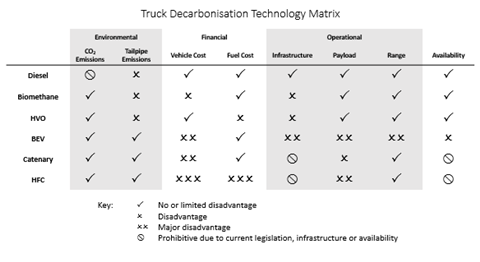To guide some of the thinking and decision-making research we’ve worked with Darren Newman at Low Carbon Truck Consultancy to produce and update a simple summary table on the vehicle and technology choices open to truck operators as they pick their way through the journey to decarbonisation.

The table attempts to highlight the pros and cons of the key technologies being promoted to help achieve carbon zero for heavy commercial vehicles. For each technology we have attempted to show the pros and cons for several elements under the headings: Environmental, Financial and Operational with a final column to show Availability in 2022.
We have used a scale when it comes to the cons. Differentiating minor disadvantages (single cross) with more difficult disadvantages (double cross) and potential show-stoppers (triple cross). Where something is simply not possible (no entry sign) this can be due to legislation or availability of products or infrastructure. Infrastructure limitations can be overcome in time, whereas legislation is unlikely to change significantly.
Speaking of legislation, there’s rumours swirling in Brussels that the next generation of Euro VII emissions regulations are under review, either being scaled back or shelved completely. A report on the Politico website, based on draft legislation, refers to an easing of Euro 7 for cars and vans, whether the same will apply to trucks will remain to be seen. An announcement from the European Commission is due in November – we’ll be sure to keep you updated.
Truck operations vary almost as widely as the products they deliver as do the trucks themselves. With such a developed industry, truck manufacturers have traditionally tried to provide models and options to suit nearly every type of operator and operation, resulting in very wide product ranges with many options making the possible different combinations running into millions.
Because of this highly diverse nature of operations the pros and cons of our table will not be identical for everyone – mission specific vehicles are likely to become a new “thing” as we move along the decarbonisation pathway. For instance, reduced range is not an issue unless you need more than is offered, reduced payload may not impact one operation as much as another and operational restrictions may be much easier to accommodate in some sectors and impossible in others.
Over the coming weeks, Freight Carbon Zero will be releasing commentary across each technology, giving some deeper insights into the technology and exploring the challenges and restrictions of each technology. We will explain how the different technologies would work in different market sectors and give as much detail on the cost implications as possible. Of course, to make a detailed plan for a specific operation will require detailed analysis and careful planning, but hopefully our table serves as a starting point to give you a better idea of when and where to start on the road to Carbon Zero.
–
Get involved in the decarbonisation conversation and comment below. We are keen to hear your thoughts and feedback



















No comments yet